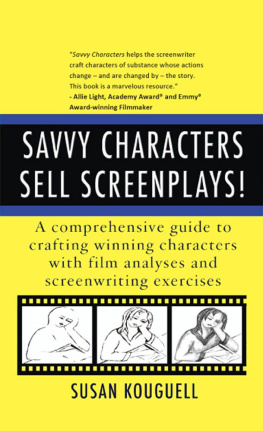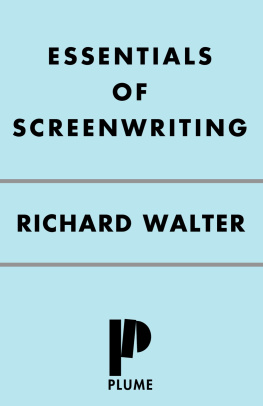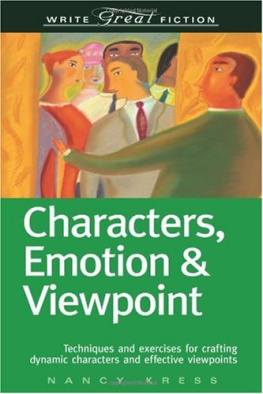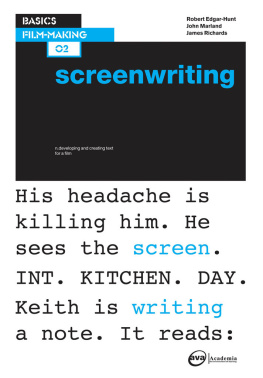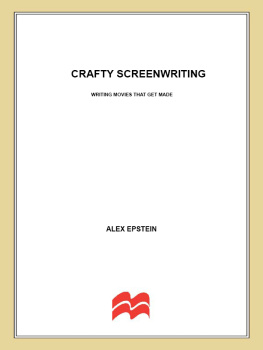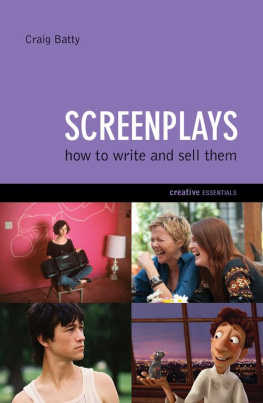SAVVY CHARACTERS SELL SCREENPLAYS!
A comprehensive guide to crafting winning characters with film analyses and screenwriting exercises
Copyright 2011 by Susan Kouguell.
All rights reserved. No part of this book may be used or reproduced in any manner whatsoever without written permission except in the case of brief quotations embodied in critical articles or reviews.
For information, contact author Susan Kouguell at
www.su-city-pictures.com
ISBN-13: 978-1463600730
ISBN-10: 1463600739
eBook ISBN: 978-1-62346-860-6
Cover design by Diana Krause Oliver
Illustration by Olga Sanina

CONTENTS
I have read the very good, the very bad, and the very ugly screenplays during my many years consulting and teaching, as well as through my work as a story analyst, story editor, and writer for film studios and production companies. As a film industry insider, I know what movie executives are looking for in a great screenplayand as a screenwriter, professor, and script consultant, I know what types of writing tools really work for my students, Su-City Pictures clients, and for me.
Since the release of my book The Savvy Screenwriter: How to Sell Your Screenplay (and Yourself) Without Selling Out!, (St. Martins Griffin)many of my students and clients suggested (okay, some demanded) I write another screenwriting book, but this time focus on crafting characters. And, they suggested (okay, they demanded) this new book offer unique writing exercises and film analyses and, like The Savvy Screenwriter, be accessible, concise and funny.
Savvy Characters Sell Screenplays! heeds my clients and students demandsand more.
Whether you are a first-time screenwriter or have written several scripts, Savvy Characters Sell Screenplays! offers inspiration and hands-on tools, guiding you through each critical element of screenwriting with the spotlight on creating and crafting compelling characters so you can write a savvy screenplay that will sell.
Thank you to Michele Meek for her generous help and creative input with copyediting and layout design, and to Jenna L. Kubly, PhD. for editing an early draft of this book. Thanks to Diana Krause Oliver for the cover design, Olga Sanina for her illustrations, and to Maurice Oliver for his technical assistance.
My deep gratitude to Tony Greco, Allie Light and Irving Saraf.
A huge thank you to my students at Tufts University and Screenwriters Online, as well as my clients at Su-City Pictures East, LLC, for their enthusiasm and commitment to screenwriting, their passion for movies, and for their inspiration and encouragement as I wrote this book.
And finally, my heartfelt thanks to Kathi and Tatiana, forever my fabulous cheerleading section; they are my gurus on words and life.
TWENTY chapters contain
THIRTY-FOUR writing exercises designed to help screenwriters unleash ideas, strengthen their characters, and break through stumbling blocks
SIX templates from fictional scripts provide hands-on assistance with constructing characters, plus
TWO HUNDRED-PLUS Hollywood, foreign, and independent movies, spanning approximately seventy years, are analyzed and referenced, offering screenwriters specific character-crafting examples to guide them through their writing process.
Savvy Characters Sell Screenplays! is more than just the aforementioned numbers; it is, as the title suggests, about characters and how to make them thrive in all the essential elements that comprise a successful script.
ITS ALL ABOUT CHARACTERS
FADE IN. A scene from a fictional screenplay between a Story Analyst and Film Executive introduces and continues with topics, including Story = Plot = Characters; analyses and examples from Syriana, Transamerica, There Will Be Blood, and Michael Clayton ; and four diverse character biography exercises.
HEROES, VILLAINS, AND THEIR SUPPORT SYSTEMS
Protagonists, antagonists, and minor characters are explored in with examples from The Da Vinci Code, All About Eve, and Five Easy Pieces.
BRINGING YOUR CHARACTERS TO LIFE
Along with a rigorous exercise, analyzes the main characters in each of these fourteen topics: Character Arcs (American Beauty), Journeys (Juno), Multidimensional (Adaptation), Empathy (Lost In Translation), Goals (The Producers), Motivations (Million Dollar Baby), Obstacles (John Q), Flaws (House of Sand and Fog), Distinct Identities (Midnight Cowboy), Unique Personalities (Being There), Vulnerability (A Beautiful Mind, The Recruit, In Her Shoes), Attitudes (Sideways), Character Transformation (Monsters Ball, Philadelphia), Characters Pasts Can Influence Their Present (Walk The Line, Brokeback Mountain, Catch Me If You Can).
WHY YOUR CHARACTERS DONT GET ALONGOR DO GET ALONG
Understanding your characters dynamics and relationships is vital in writing a savvy screenplay. Each subject in . Here, youll also find a list of one hundred and one adjectives to describe your characters. Both chapters contain unique exercises.
CHARACTERS WORDS AND NARRATIVE KNOW-HOW
Writing outstanding dialogue is essential to a successful screenplay, as detailed in , along with analyses of Some Like It Hot, Little Miss Sunshine, What Ever Happened To Baby Jane?, The Sixth Sense, A History of Violence, and Good Night, and Good Luck.
LOCATION, LOCATION, LOCATION
Transport your readers to intriguing locales, as the topic of Settings is the milieu in . How characters relate to their various environments are detailed in Atlantic City followed by brief analyses of Waitress, Midnight Cowboy, American Beauty, Lost in Translation, Easy Rider, Smoke Signals, Alice in the Cities, and Vagabond. A sizzling setting exercise concludes this chapter.
WHAT DOES IT REALLY MEAN?
reveals metaphors with examples from Body Heat, Mystic River, In the Bedroom, Little Miss Sunshine, The Ice Storm, and Minority Report. Both chapters have nifty exercises.
GETTING YOUR ACT(S) TOGETHER
Structure headlines , which contains valuable exercises; discussions about Acts, 1, 2, and 3; and traditional, nontraditional, and nonlinear narrative structures with analyses of Black Hawk Down, Finding Nemo, Run Lola Run, Memento, Eternal Sunshine of the Spotless Mind, Unfaithful, Matchstick Men, and Phone Booth.
SCENES, SCENES, SCENES
Scene objectives, scene pacing, scene arcs, and an exercise are found in , youll find a discussion about Story Beats with an exercise and detailed example from Body Heat.
CAUSE AND EFFECT, BAD HABITS, AND CLASSIFICATIONS
In defines genres and subgenres, emphasizing what your characters must do in each category, along with film examples. Each of these chapters has an exercise.
WORDS OF WISDOM
The last chapter offers some final advice and concludes with a fictional scene between the Story Analyst and Film Executive. FADE OUT.
FADE IN
INT. MOVIE STUDIO OFFICE - NIGHT
Harsh florescent lights illuminate a large office filled with small cubicles, each with a computer and stacks of screenplays. Film posters line the walls.
Its after hours, and the employees appear to have gone. The BUZZ of florescent lights is the only sound until-- GIGGLES and PAGES rapidly turning are heard.
Suddenly, female legs jut out on the floor from underneath one of the desks. On closer inspection, STORY ANALYST, 20s, timid yet brainy, is revealed lying underneath her desk buried in piles of screenplays. Enthralled with the last page of a script, she closes it and smiles.
FILM EXECUTIVE, 50s, rushes in. Shes tough, authoritative, and impeccably dressed with every hair in place.
Story Analyst jumps to attention, BANGING her head on the desk as she rises. Realizing her disheveled appearance, she attempts to straighten herself out, as Film Executive impatiently stares her down.
Next page
